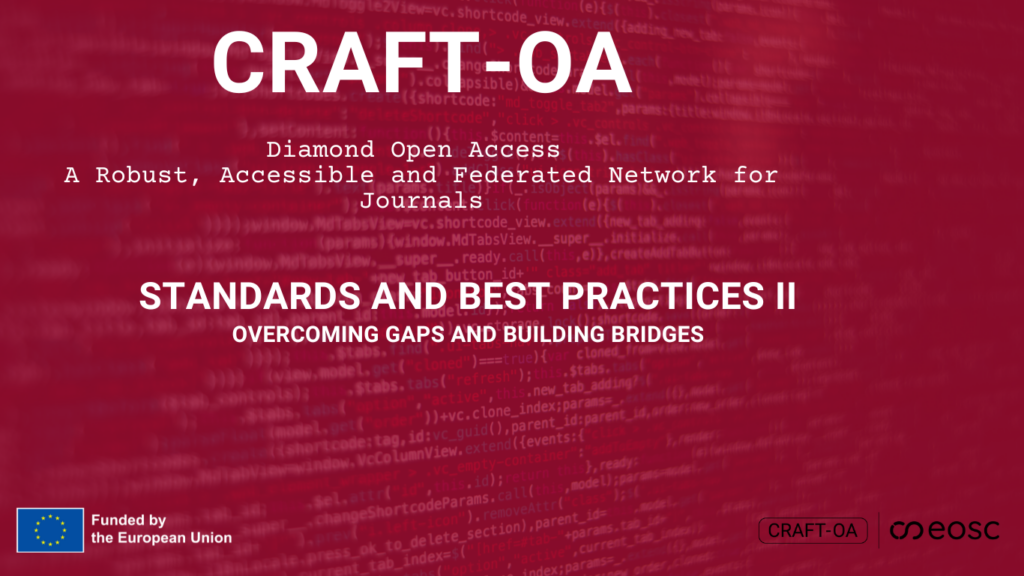The Technological Landscape of Open Access Diamond Journals
This blog is a synopsis of CRAFT-OA Deliverable 3.2 Report on challenges and help measures faced by OA journals and platforms. The synopsis was written by Kristina Posavec, Maxim Kupreyev & Sona Arasteh.
Open Access Diamond Journals (OADJs) are pivotal stakeholders in Open Science, serving as conduits for the unrestricted flow of knowledge in contemporary societies. Yet, OADJs face challenges in meeting recommended technological standards and services in a landscape marked by heterogeneity and distribution.
Having assembled standards for best Diamond OA publishing practices, CRAFT-OA has continued this work by identifying the gaps in the implementation of these standards as described below. In the future, the project will provide training materials to overcome these gaps – sign up for our newsletter to be aware of all project developments here.
To gain insights into the current technological state of OADJs, the CRAFT-OA team analysed the challenges and help measures faced by OA journals and platforms, thereby identifying gaps between recommended best practices and the actual practices of OADJs. This analysis includes an evaluation of the uptake of recognized standards and practices using data from various sources, including surveys on the OADJ landscape and information from the Directory of Open Access Journals (DOAJ).
This gap analysis provides a comprehensive overview of various standards and features related to identifiers, metadata, content, and website functionalities in the context of scholarly publishing, emphasizing the challenges and the need for ongoing efforts to improve practices and adoption.
Identifiers
Identifiers such as International Standard Serial Numbers (ISSN/eISSN), Contributor ID (ORCID), ROR, ARK, Handle, DOI, and Funder DOIs/PIDs, play a significant role in scholarly publishing, e.g. for indexing. While identifiers such as DOIs are relatively widely used in Diamond publishing, effort is still required to promote alternative identifiers and address disciplinary variations. Challenges for OADJs that hinder the update of these identifiers are lacking awareness and keeping up with the ongoing (technological) evolution of standards.
Metadata
Given its importance for findability and interoperability, high-quality metadata is crucial in OA publishing. Challenges concerning metadata include a lack of human resources and expertise, and non-compliance, particularly among smaller publishers. Specific metadata standards, such as metadata protocol for harvesting (e.g., OAI-PMH), OpenAIRE Guidelines, mass metadata export, KBART, metadata about OA status, and registering of a self-archiving policy come with challenges and gaps explicitly associated with them. This need for improvement can be met by adopting publishing systems with built-in functionalities for better metadata management.
Content
“Content” in this context means text and data mining support, digital preservation, the provisioning of full texts in machine-readable formats (JATS-, TEI-, ONYX-XML, but also HTML with meta-tags), depositing protocols for digital preservation (e.g., SWORD), data mining and harvesting support (e.g., via OAI-PMH). While the adoption of standards is progressing, challenges still persist – including incomplete adoption and financial constraints. Particular efforts should be made to enhance open access initiatives and address content and content management challenges across scholarly journals.
Websites
Websites serve as “shop windows” for journals, with technical functionalities enhancing findability and usability. Key features like article landing pages and search engine optimization (SEO) contribute to visibility. Optimal indexing is hindered by the absence of HTML meta-tags (Highwire, Dublin Core), keywords, sitemap in “robot.txt file, etc. Emphasizing the importance of unique URLs, linking to related research objects, and concludes by highlighting the significance of COUNTER in ensuring credible usage statistics for electronic resources.
Four case studies of European journal portals—OpenEdition, Journal.fi, HRČAK, and ZRC SAZU—offer a unique perspective on the adoption and support of standards. These case studies shed light on how gaps manifest in different national and technological contexts. The gap analysis conducted by CRAFT-OA has produced two overall insights:
- The uptake of recommended standards has significant room for growth across various OADJs.
- The identified gaps stem from technological challenges, resource limitations, expertise constraints, and, often, a lack of awareness.
As mentioned above, CRAFT-OA is working to address the identified gaps through a suite of training resources and events tailored specifically for the OADJ audience. This includes workshops, a self-assessment checklist, online learning materials, and a FAIRification toolkit. The materials will be accessible even after the project concludes, allowing journals, platforms, and infrastructures to assess and enhance their compliance with standards.
Furthermore, CRAFT-OA sets out to take on the lack of awareness and technological competencies identified as the main challenges to overcoming the gaps mentioned above. By establishing a sustainable network of IPTPs (Institutional Publishing Technology Providers), training, and a close collaboration with the DIAMAS project working on best practices and policy recommendations, CRAFT-OA intends further to build the capacity of the Diamond OA community.
